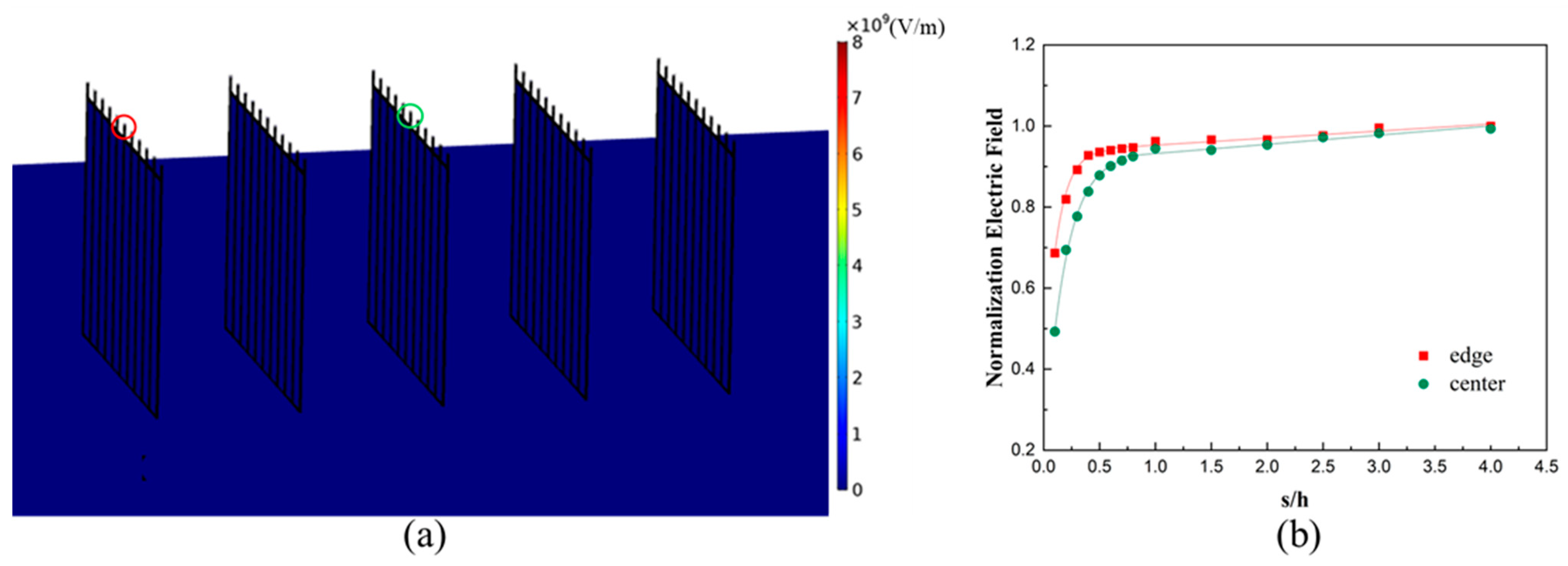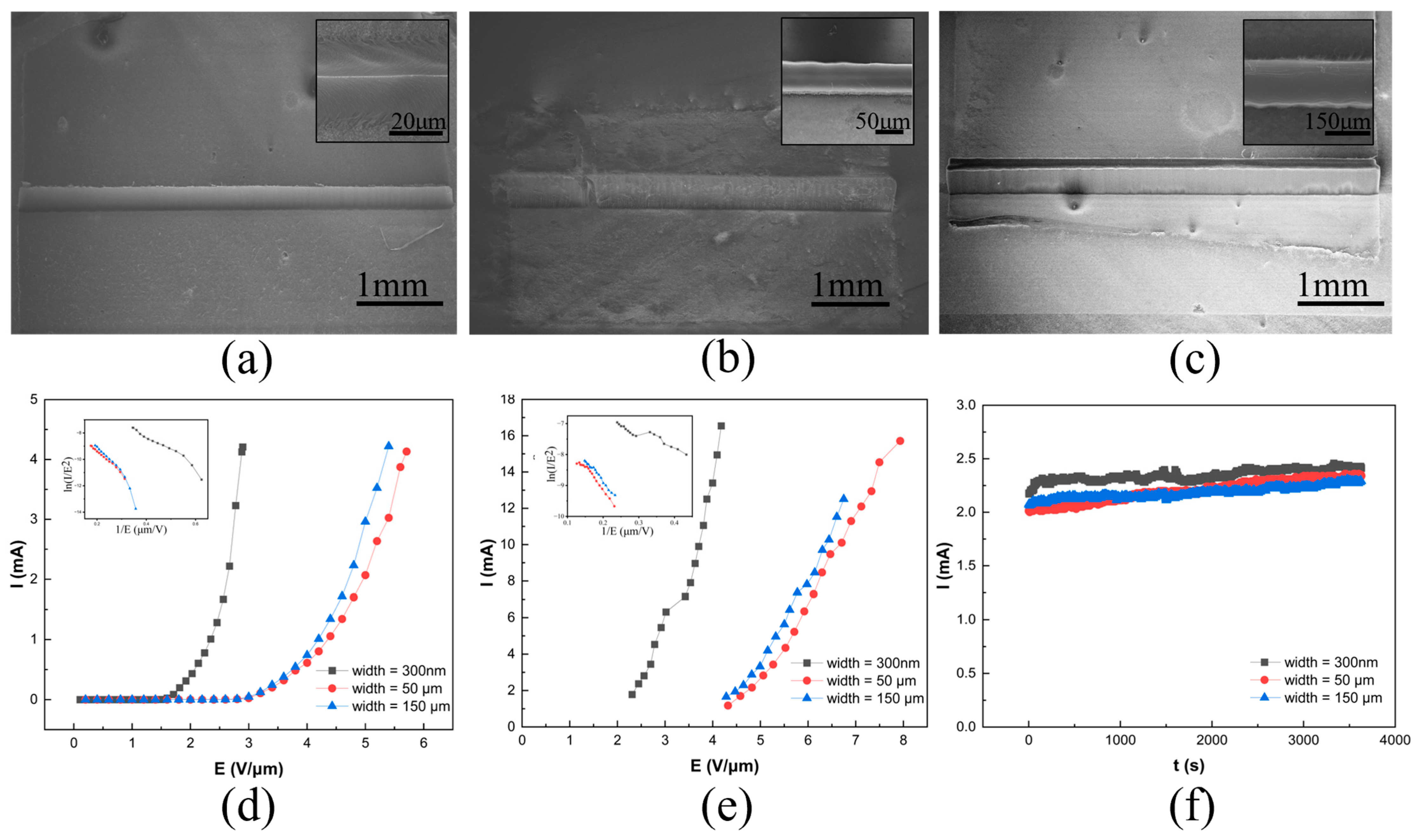Two-Dimensional Fin-Shaped Carbon Nanotube Field Emission Structure with High Current Density Capability
Abstract
:1. Introduction
2. Materials and Methods
3. Results
4. Conclusions
Author Contributions
Funding
Data Availability Statement
Conflicts of Interest
References
- Han, J.S.; Lee, S.H.; Go, H.; Kim, S.J.; Noh, J.H.; Lee, C.J. High-performance cold cathode X-ray tubes using a carbon nanotube field electron emitter. ACS Nano 2022, 16, 10231–10241. [Google Scholar] [CrossRef] [PubMed]
- Puett, C.; Inscoe, C.; Hartman, A.; Calliste, J.; Franceschi, D.K.; Lu, J.; Zhou, O.; Lee, Y.Z. An update on carbon nanotube-enabled X-ray sources for biomedical imaging. Wiley Interdiscip. Rev. Nanomed. Nanobiotechnol. 2017, 10, e1475. [Google Scholar] [CrossRef]
- Yuan, X.; Zhu, W.; Zhang, Y.; Xu, N.; Yan, Y.; Wu, J.; Shen, Y.; Chen, J.; She, J.; Deng, S. A fully-sealed carbon-nanotube cold-cathode terahertz gyrotron. Sci. Rep. 2016, 6, 32936. [Google Scholar] [CrossRef] [PubMed]
- Ren, J.; Zhang, Y.; Ke, Y.; Jiang, J.; She, J.; Deng, S. A W-Band backward wave oscillator based on carbon nanotube cold cathode. IEEE Trans. Electron Devices 2024, 72, 859–865. [Google Scholar] [CrossRef]
- Yuan, X.; Chen, Q.; Xu, X.; Cole, M.T.; Zhang, Y.; Chen, Z.; Yan, Y. A carbon nanotube-based hundred watt-level Ka-band backward wave oscillator. IEEE Trans. Electron Devices 2021, 68, 2467–2472. [Google Scholar] [CrossRef]
- Xu, N.S.; Huq, S.E. Novel cold cathode materials and applications. Mat. Sci. Eng. R Rep. 2005, 48, 47–189. [Google Scholar] [CrossRef]
- Verma, P.; Gautam, S.; Kumar, P.; Chaturvedi, P.; Rawat, J.S.; Pal, S.; Chaubey, R.; Harsh; Vyas, H.P.; Bhatnagar, P.K. Carbon nanotube tip melting with vacuum breakdown in cold cathode. J. Vac. Sci. Technol. B 2007, 25, 1584–1587. [Google Scholar] [CrossRef]
- Huang, N.Y.; She, J.C.; Chen, J.; Deng, S.Z.; Xu, N.S.; Bishop, H.; Huq, S.E.; Wang, L.; Zhong, D.Y.; Wang, F.E.; et al. Mechanism responsible for initiating carbon nanotube vacuum breakdown. Phys. Rev. Lett. 2004, 93, 075501. [Google Scholar] [CrossRef]
- Chen, J.; Chang, X.; Ma, G.; Zhu, Y.; Yang, B.; Zhao, Y.; Chen, J.; Li, Y. Boosting field electron emission of carbon nanotubes through small-hole-patterning design of the substrate. J. Phys. D Appl. Phys. 2023, 57, 095302. [Google Scholar] [CrossRef]
- Chen, J.; Chang, X.; Wu, S.; Ren, H.; Zhu, Y.; Yang, B.; Zhao, Y.; Chen, J.; Li, Y. “Double-high” field electron emission of screen-printed carbon nanotube cathodes. Vacuum 2023, 217, 112517. [Google Scholar] [CrossRef]
- Liu, J.A.; Wang, J.; Cheraghi, E.; Chen, S.; Sun, Y.; Yeow, J.T. Improvement of field emission performances by DMSO and PEDOT: PSS treated freestanding CNT clusters. Nanoscale 2022, 14, 15364–15372. [Google Scholar] [CrossRef] [PubMed]
- Kumar, G.; Gupta, H.; Ghosh, S.; Srivastava, P. Highly enhanced field emission from vertically aligned carbon nanotubes grown on a patterned substrate via non-lithographic method. Phys. E Low-Dimens. Syst. Nanostruct. 2022, 135, 114946. [Google Scholar] [CrossRef]
- Neupane, S.; Lastres, M.; Chiarella, M.; Li, W.; Su, Q.; Du, G. Synthesis and field emission properties of vertically aligned carbon nanotube arrays on copper. Carbon 2012, 50, 2641–2650. [Google Scholar] [CrossRef]
- Li, M.; Wang, Q.; Xu, J.; Zhang, J.; Qi, Z.; Zhang, X. Optically induced field-emission source based on aligned vertical carbon nanotube arrays. Nanomaterials 2021, 11, 1810. [Google Scholar] [CrossRef] [PubMed]
- Fairchild, S.B.; Zhang, P.; Park, J.; Back, T.C.; Marincel, D.; Huang, Z.; Pasquali, M. Carbon nanotube fiber field emission array cathodes. IEEE Trans. Plasma Sci. 2019, 47, 2032–2038. [Google Scholar] [CrossRef]
- Cai, D.; Liu, L. The screening effects of carbon nanotube arrays and its field emission optimum density. AIP Adv. 2013, 3, 122103. [Google Scholar] [CrossRef]
- Suh, J.S.; Jeong, K.S.; Lee, J.S.; Han, I. Study of the field-screening effect of highly ordered carbon nanotube arrays. Appl. Phys. Lett. 2002, 80, 2392–2394. [Google Scholar] [CrossRef]
- Tang, X.; Yue, H.; Liu, L.; Luo, J.; Wu, X.; Zheng, R.; Cheng, G. Vertically aligned carbon nanotube microbundle arrays for field-emission applications. ACS Appl. Nano Mater. 2020, 3, 7659–7667. [Google Scholar] [CrossRef]
- Zhao, J.; Li, Z.; Cole, M.T.; Wang, A.; Guo, X.; Liu, X.; Lyu, W.; Teng, H.; Qv, Y.; Liu, G.; et al. Nanocone-shaped carbon nanotubes field-emitter array fabricated by laser ablation. Nanomaterials 2021, 11, 3244. [Google Scholar] [CrossRef]
- Burtsev, A.A. Formation and focusing of converging sheet electron beam based on field emission. Electron. Lett. 2018, 54, 839–840. [Google Scholar] [CrossRef]
- Burtsev, A.A.; Pavlov, A.A.; Kitsyuk, E.P.; Grigor’ev, Y.A.; Danilushkin, A.V.; Shumikhin, K.V.E. Studying the field emission cathode–gate structure based on carbon nanotubes for electron-optical systems with a sheet beam. Tech. Phys. Lett. 2017, 43, 542–544. [Google Scholar] [CrossRef]
- Wang, S.; Aditya, S.; Miao, J.; Xia, X. Design of a Sheet-Beam Electron-Optical System for a Microfabricated W band traveling-wave tube using a cold cathode. IEEE Trans. Electron Devices 2016, 63, 3725–3732. [Google Scholar] [CrossRef]
- Zhang, C.; Pan, P.; Cai, J.; Chen, X.; Tian, H.; Su, S.; Zhou, K.; Meng, W.; Li, Y.; Song, B.; et al. Demonstration of a PCM-focused sheet beam TWT amplifier at G-band. IEEE Trans. Electron Devices 2023, 70, 2798–2803. [Google Scholar] [CrossRef]
- Latif, J.; Gong, H.; Wang, Z.; Jameel, A.; Wang, S.; Feng, J.; Gong, Y. Performance Evaluation and Experimental Study of a 0.34-THz Folded Waveguide Sheet Beam BWO. J. Infrared Millim. Terahertz Waves 2024, 45, 504–520. [Google Scholar] [CrossRef]
- Pop, E.; Mann, D.; Wang, Q.; Goodson, K.; Dai, H. Thermal conductance of an individual single-wall carbon nanotube above room temperature. Nano Lett. 2006, 6, 96–100. [Google Scholar] [CrossRef]
- Gao, Y.; Marconnet, A.M.; Xiang, R.; Maruyama, S.; Goodson, K.E. Heat capacity, thermal conductivity, and interface resistance extraction for single-walled carbon nanotube films using frequency-domain thermoreflectance. IEEE Trans. Compon. Packag. Manuf. Technol. 2013, 3, 1524–1532. [Google Scholar] [CrossRef]
- Jakubinek, M.B.; White, M.A.; Li, G.; Jayasinghe, C.; Cho, W.; Schulz, M.J.; Shanov, V. Thermal and electrical conductivity of tall, vertically aligned carbon nanotube arrays. Carbon 2010, 48, 3947–3952. [Google Scholar] [CrossRef]
- Sugime, H.; Esconjauregui, S.; D’Arsié, L.; Yang, J.; Robertson, A.W.; Oliver, R.A.; Bhardwaj, S.; Cepek, C.; Robertson, J. Low-temperature growth of carbon nanotube forests consisting of tubes with narrow inner spacing using Co/Al/Mo catalyst on conductive supports. ACS Appl. Mater. Interfaces 2015, 7, 16819–16827. [Google Scholar] [CrossRef]
- Laurent, C.; Flahaut, E.; Peigney, A. The weight and density of carbon nanotubes versus the number of walls and diameter. Carbon 2010, 48, 2994–2996. [Google Scholar] [CrossRef]
- Xu, Z.; Bai, X.D.; Wang, E.G.; Wang, Z.L. Field emission of individual carbon nanotube with in situ tip image and real work function. Appl. Phys. Lett. 2005, 87, 163106. [Google Scholar] [CrossRef]
- Giubileo, F.; Iemmo, L.; Luongo, G.; Martucciello, N.; Raimondo, M.; Guadagno, L.; Passacantando, M.; Lafdi, K.; Di Bartolomeo, A. Transport and field emission properties of buckypapers obtained from aligned carbon nanotubes. J. Mater. Sci. 2017, 52, 6459–6468. [Google Scholar] [CrossRef]
- Giubileo, F.; Capista, D.; Faella, E.; Pelella, A.; Kim, W.Y.; Benassi, P.; Passacantando, M.; Di Bartolomeo, A. Local characterization of field emission properties of graphene flowers. Adv. Electron. Mater. 2023, 9, 2200690. [Google Scholar] [CrossRef]
- Pelella, A.; Grillo, A.; Urban, F.; Giubileo, F.; Passacantando, M.; Pollmann, E.; Sleziona, S.; Schleberger, M.; Di Bartolomeo, A. Gate-Controlled Field Emission Current from MoS2 Nanosheets. Adv. Electron. Mater. 2021, 7, 2000838. [Google Scholar] [CrossRef]
- Thong, J.T.L.; Oon, C.H.; Eng, W.K.; Zhang, W.D.; Gan, L.M. High-current field emission from a vertically aligned carbon nanotube field emitter array. Appl. Phys. Lett. 2001, 79, 2811–2813. [Google Scholar] [CrossRef]
- Thapa, A.; Poudel, Y.R.; Guo, R.; Jungjohann, K.L.; Wang, X.; Li, W. Direct synthesis of micropillars of vertically aligned carbon nanotubes on stainless-steel and their excellent field emission properties. Carbon 2021, 171, 188–200. [Google Scholar] [CrossRef]






| Cathodes | Area | Maximum Emission Current | Current Density | Field Enhancement Factor | Turn-On Field (V/μm) |
|---|---|---|---|---|---|
| Single CNT [30] | - | 14.5 μA | - | 1325 | - |
| Buckypaper [31] | 1 μm2 | 10 μA | 1000 A/cm2 | 30 | 140 (0.01 nA) |
| Vertical graphene [32] | 1 μm2 | 31 nA | 3.1 A/cm2 | 32 | 70 (1 pA) |
| Single MoS2 nanosheet [33] | - | 20 nA | - | 17 | 100 |
| Vertical CNT film [34] | 0.36 mm2 | 2 mA | 0.555 A/cm2 | 3000 | 1 V (10 μA/cm2) |
| Vertical CNT array [13] | 1 cm2 | 1 mA | 0.001 A/cm2 | 1760 | 4.71 (1 μA/cm2) |
| Vertical CNT array [35] | 0.803 cm2 | 26.5 mA | 0.033 A/cm2 | 4977 | 1.57 (1 μA/cm2) |
| Cone-shaped CNT array [19] | 0.04 cm2 | 5.78 mA | 0.145 A/cm2 | - | 1.6 (1 μA) |
| Single fin-shaped CNT emitter (this work) | 0.0015 mm2 | 16.55 mA | 1103.33 A/cm2 | 13,858 | 1.49 (10 μA) |
| Fin-shaped CNT array (this work) | 0.25 cm2 | 87.29 mA | 0.349 A/cm2 | 12,140 | 0.81 (10 μA) |
Disclaimer/Publisher’s Note: The statements, opinions and data contained in all publications are solely those of the individual author(s) and contributor(s) and not of MDPI and/or the editor(s). MDPI and/or the editor(s) disclaim responsibility for any injury to people or property resulting from any ideas, methods, instructions or products referred to in the content. |
© 2025 by the authors. Licensee MDPI, Basel, Switzerland. This article is an open access article distributed under the terms and conditions of the Creative Commons Attribution (CC BY) license (https://creativecommons.org/licenses/by/4.0/).
Share and Cite
Qin, X.; Ding, Y.; Jiang, J.; Liang, J.; Ke, Y.; She, J.; Zhang, Y.; Deng, S. Two-Dimensional Fin-Shaped Carbon Nanotube Field Emission Structure with High Current Density Capability. Electronics 2025, 14, 1268. https://doi.org/10.3390/electronics14071268
Qin X, Ding Y, Jiang J, Liang J, Ke Y, She J, Zhang Y, Deng S. Two-Dimensional Fin-Shaped Carbon Nanotube Field Emission Structure with High Current Density Capability. Electronics. 2025; 14(7):1268. https://doi.org/10.3390/electronics14071268
Chicago/Turabian StyleQin, Xiaoyu, Yulong Ding, Jun Jiang, Junzhong Liang, Yanlin Ke, Juncong She, Yu Zhang, and Shaozhi Deng. 2025. "Two-Dimensional Fin-Shaped Carbon Nanotube Field Emission Structure with High Current Density Capability" Electronics 14, no. 7: 1268. https://doi.org/10.3390/electronics14071268
APA StyleQin, X., Ding, Y., Jiang, J., Liang, J., Ke, Y., She, J., Zhang, Y., & Deng, S. (2025). Two-Dimensional Fin-Shaped Carbon Nanotube Field Emission Structure with High Current Density Capability. Electronics, 14(7), 1268. https://doi.org/10.3390/electronics14071268






